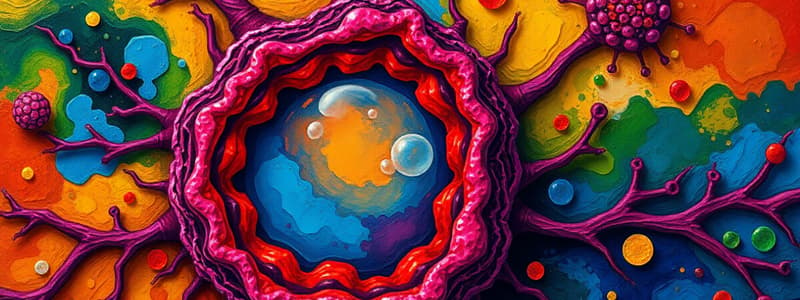Podcast
Questions and Answers
Qual fase del periodo de reposo implica un aumento de tamaño de celula?
Qual fase del periodo de reposo implica un aumento de tamaño de celula?
- Fase S
- Fase G2
- Fase M
- Fase G1 (correct)
Que processo ocurre durante la fase G1?
Que processo ocurre durante la fase G1?
- Duplicacion del ADN
- Sintesis de ARN e proteínas (correct)
- División celular
- Reparación del ADN
Qual caracteristica es associata con la fase G1?
Qual caracteristica es associata con la fase G1?
- Las celulas empiezan la división
- Los cromosomas se extienden (correct)
- La célula se prepara para la mitosis
- Los cromosomas son altamente condensados
Cuantas fases componen el periodo de reposo entre divisiones celulares?
Cuantas fases componen el periodo de reposo entre divisiones celulares?
Cual es el objetivo principal de la fase G1?
Cual es el objetivo principal de la fase G1?
Quo es le function principal del aparato de Golgi?
Quo es le function principal del aparato de Golgi?
Quo representante le orgánulos de forma de vesículas qui proveni del aparato de Golgi?
Quo representante le orgánulos de forma de vesículas qui proveni del aparato de Golgi?
Qual tipo de orgánulos es descrite como vesículas procedentes del aparato de Golgi?
Qual tipo de orgánulos es descrite como vesículas procedentes del aparato de Golgi?
Quo define un orgánulo vesicular?
Quo define un orgánulo vesicular?
Qual es le relation inter le aparato de Golgi e le orgánulos vesiculares?
Qual es le relation inter le aparato de Golgi e le orgánulos vesiculares?
Flashcards
Vesiculas derivate del apparato de Golgi
Vesiculas derivate del apparato de Golgi
Organellos que ha forma de vesiculas, e que es derivate del apparato de Golgi.
Vesicula
Vesicula
Un organello cellular que ha un forma de sacculo,
Apparato de Golgi
Apparato de Golgi
Un fabricator de proteina e lipides que prepara e pacieta moleculas pro le cellula.
Formation de vesiculas
Formation de vesiculas
Signup and view all the flashcards
Importantia del apparato de Golgi
Importantia del apparato de Golgi
Signup and view all the flashcards
Interfase
Interfase
Signup and view all the flashcards
Phase G1
Phase G1
Signup and view all the flashcards
Synthesis de RNA e Proteinas in G1
Synthesis de RNA e Proteinas in G1
Signup and view all the flashcards
Extension e Duplication de Cromosomas in G1
Extension e Duplication de Cromosomas in G1
Signup and view all the flashcards
Control de Condiciones in G1
Control de Condiciones in G1
Signup and view all the flashcards
Study Notes
General Organism Structure and Organization
- Living organisms exist as single-celled or multicellular. Multicellular organisms are more structurally complex.
- Key structural levels are:
- Chemical: Basic components of cells (atoms and molecules). These don't perform life functions.
- Cellular: The fundamental unit of life. It carries out life functions such as reproduction, interaction, and nutrition.
- Tissue: Groups of cells with similar function and structure performing specialized roles
- Organ: Groups of tissues working together to conduct complex functions
- Systems/Apparatuses: Organized groups of organs working toward a common goal. These are further subdivided into organ systems, including musculoskeletal, circulatory, endocrine, etc., and also organ apparatuses, including digestive, urinary, respiratory, reproductive, cardiovascular, and locomotor.
Cells
- Cells are the basic unit of life, carrying out life processes
- Prokaryotic Cells:
- Lacks a defined nucleus.
- Genetic material (DNA) is free-floating in the cytoplasm.
- Bacteria are examples of prokaryotic cells.
- Eukaryotic Cells:
- Possess a defined nucleus with a membrane separating it from the cytoplasm.
- Have various membrane-bound organelles (e.g., mitochondria, ribosomes, endoplasmic reticulum, Golgi apparatus).
Cell Structure
- All cells share basic structures: plasma membrane, cytoplasm, and genetic material (DNA).
- Plasma membrane: A phospholipid bilayer with embedded proteins that controls substance passage into and out of the cell.
- Cytoplasm: The gel-like substance within the cell, containing organelles and dissolved substances.
- Genetic material/DNA: Guides cell activities, located in the nucleus of eukaryotic cells.
Cell Function
- Cells perform specific functions related to nutrition, interaction, and reproduction.
- Nutrition: Intake of nutrients from the environment for energy and growth.
- Interaction: Responding to external stimuli and interacting with other cells.
- Reproduction: Creating new cells (mitosis for growth and repair; meiosis for sexual reproduction).
Tissues
- Tissues are groups of cells that perform a specific function.
- Types of Tissues: Epithelial, connective, nervous, and muscle.
Organs
- Organs are structures comprising of different tissue types, having a specific function.
- Organs are often composed of several different tissue types that function together
Systems
- Biological systems are composed of multiple organs that work together toward a shared purpose.
- Major body systems include the circulatory, digestive, nervous, urinary, and other systems.
Studying That Suits You
Use AI to generate personalized quizzes and flashcards to suit your learning preferences.




